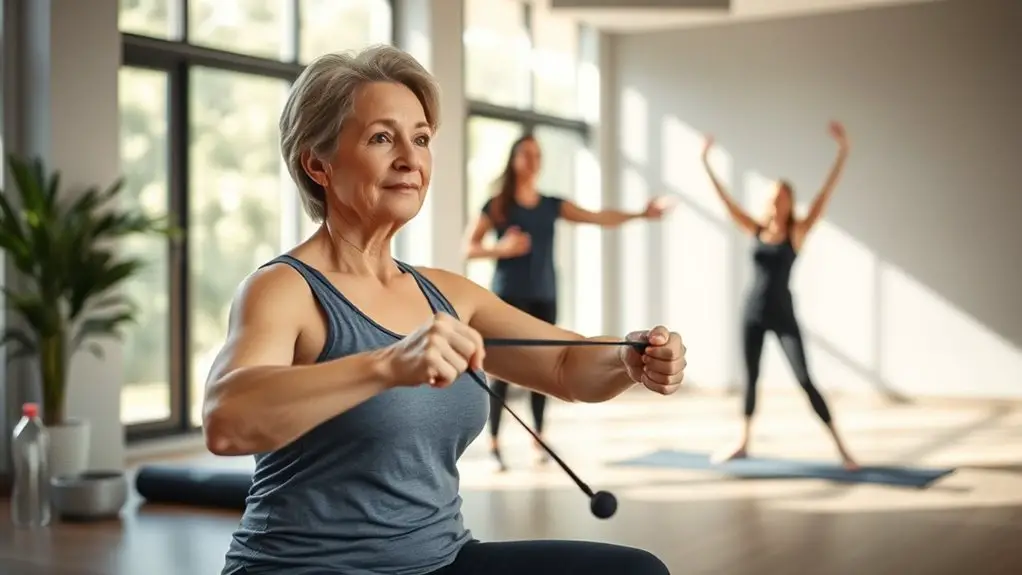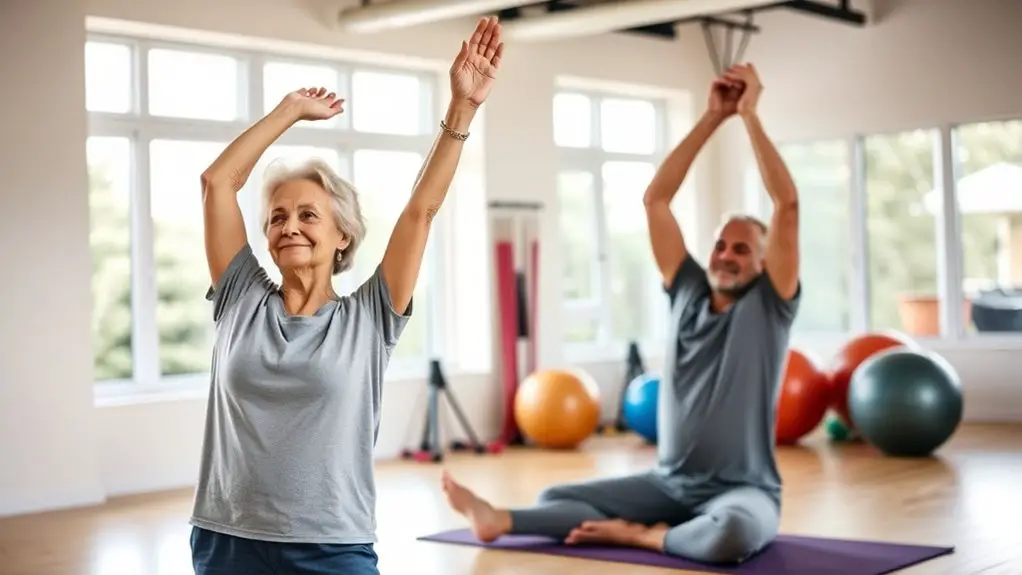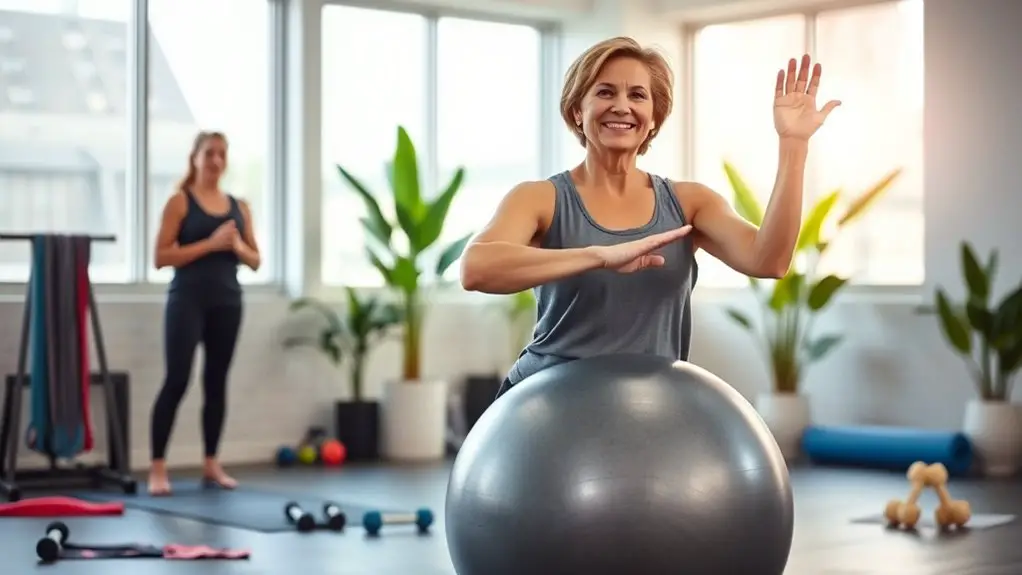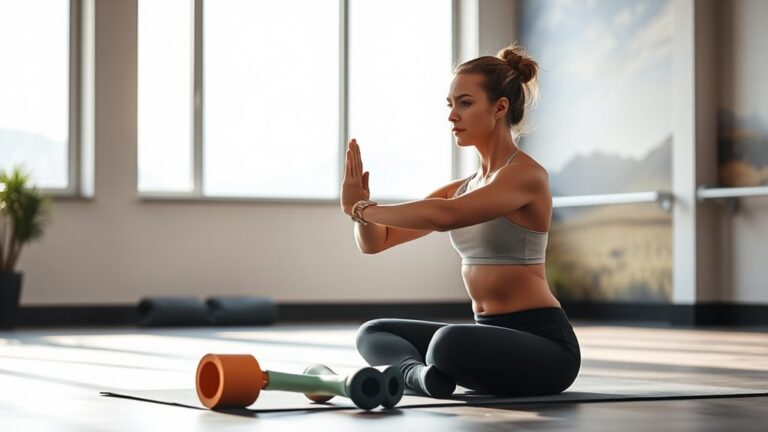The Best Gym Exercises for Arthritis Relief

For arthritis relief, focus on low-impact cardio like stationary cycling or using an elliptical to improve cardiovascular health while minimizing joint stress. Incorporate strength training exercises, such as Leg Press and Dumbbell Shoulder Press, to enhance joint stability. Don’t forget flexibility stretches, like yoga poses, to maintain range of motion. Consider water-based activities for gentle resistance that reduces pain. Balance and coordination workouts, such as Tai Chi, can also help. There’s more to explore on how to best support your joints.
Low-Impact Cardio Options

When managing arthritis, incorporating low-impact cardio options can be beneficial for maintaining joint mobility and overall fitness without exacerbating pain. Two excellent choices are stationary cycling and elliptical machines.
Stationary cycling allows you to engage in aerobic exercise while minimizing stress on your joints. You can adjust the resistance to suit your comfort level, guaranteeing a personalized workout. This helps improve cardiovascular health while keeping your joints stable. Additionally, strengthening exercises can build muscle support around knee joints, further enhancing your workout experience.
Stationary cycling offers a personalized, low-impact workout that boosts cardiovascular health while protecting your joints.
Elliptical machines also provide a low-impact alternative, offering a smooth gliding motion that reduces strain on the knees and hips. By using these machines, you can enjoy a full-body workout that enhances endurance and circulation.
Both options allow you to exercise at your own pace, making them suitable for various fitness levels. Remember to listen to your body, and consult with your healthcare provider before starting any new exercise routine to make sure it aligns with your specific needs.
Strength Training for Joint Stability
Incorporating strength training into your fitness routine can greatly enhance joint stability and reduce arthritis-related discomfort. Engaging in resistance training promotes joint strengthening by building the muscles surrounding your joints, which can alleviate pressure and improve mobility. Focus on low-impact exercises, and consider working with a professional to guarantee proper form. Additionally, implementing exercises like Renegade Rows can further support core strength and stability, essential for overall joint health.
Here’s a simple table to help guide your strength training journey:
| Exercise | Reps | Sets |
|---|---|---|
| Leg Press | 10-15 | 2-3 |
| Seated Row | 10-15 | 2-3 |
| Dumbbell Shoulder Press | 8-12 | 2-3 |
Flexibility and Stretching Exercises

Flexibility and stretching exercises play an essential role in managing arthritis symptoms, as they help maintain joint function and reduce stiffness. Incorporating gentle movements into your routine can greatly improve your range of motion and ease discomfort. Simple yoga poses, such as the cat-cow stretch or seated forward bend, can gently elongate your muscles and improve flexibility without putting excessive strain on your joints.
It’s vital to listen to your body during these exercises. Start slowly, focusing on your breath and maintaining a relaxed posture. Regularly practicing these stretches can help prevent tightness, promote circulation, and enhance your overall well-being. Consider dedicating a few minutes each day to these movements, as consistency is key for long-term relief. Remember, the goal is to find a balance that works for you, ensuring that you’re comfortable while enhancing your mobility and reducing the impact of arthritis on your daily life.
Water-Based Activities for Pain Relief
While many traditional exercises can be challenging for those with arthritis, water-based activities offer a gentle alternative that can greatly alleviate pain and discomfort. Aquatic therapy provides an environment where the buoyancy of water reduces joint stress, allowing you to move more freely. This can lead to improved flexibility and reduced pain during activity.
Resistance swimming is another excellent option, as water naturally provides resistance, helping to strengthen muscles without overexerting your joints. The resistance can be adjusted by changing your speed or using aquatic equipment, tailoring the workout to your specific needs.
Engaging in these activities regularly can enhance your overall well-being, improve mobility, and help manage arthritis symptoms. Always consult your healthcare provider before starting any new exercise regimen, but incorporating water-based activities into your routine can be a revitalizing and effective way to promote arthritis relief.
Balance and Coordination Workouts

Improving balance and coordination can be essential for those with arthritis, as these skills not only enhance stability but also reduce the risk of falls. Incorporating balance drills and coordination games into your routine can greatly benefit your overall mobility. Here are some effective exercises to try:
- Single-leg stands: Hold onto a sturdy surface and lift one leg, balancing for 10-30 seconds.
- Heel-to-toe walk: Walk in a straight line, placing the heel of one foot directly in front of the toes of the other.
- Tai Chi: This gentle practice focuses on slow, controlled movements, enhancing both balance and coordination.
- Balance board exercises: Use a balance board to challenge your stability while engaging core muscles.
Frequently Asked Questions
Can I Exercise With Arthritis Every Day?
Imagine your joints as a well-oiled machine; they thrive on movement. Yes, you can exercise every day with arthritis, but it’s crucial to listen to your body. Incorporating gentle activities into your daily routines can release tremendous exercise benefits, such as improved flexibility and reduced stiffness. Just remember to choose low-impact options and consult a healthcare professional to tailor a plan that suits your needs, ensuring you stay safe and active.
What Are the Best Warm-Up Exercises for Arthritis?
When considering warm-up exercises for arthritis, gentle stretching and low-impact activities are essential. Start with light neck and shoulder rolls to ease tension, followed by ankle circles to improve mobility. Incorporating gentle arm and leg stretches can enhance flexibility without straining your joints. Activities like walking or stationary cycling can also serve as effective warm-ups, gradually increasing your heart rate while minimizing stress on your body. Always listen to your body and adjust accordingly.
How Do I Know if I’m Overdoing It?
To know if you’re overdoing it, pay close attention to your body’s pain signals. If you experience increased discomfort during or after activity, it’s a sign you might be pushing your limits. It’s crucial to recognize your activity limits and adjust accordingly. Start slow, and gradually increase intensity while monitoring your pain levels. If pain persists or worsens, consult a healthcare professional to verify you’re not exacerbating any underlying conditions.
Should I Consult a Doctor Before Starting an Exercise Routine?
Yes, consulting a doctor before starting any exercise routine is essential, especially if you have existing health concerns. A doctor can provide tailored recommendations based on your individual needs and help you understand the exercise benefits specific to your situation. They’ll assess your health status and may suggest modifications to guarantee safety. It’s always best to get professional advice to prevent injury and maximize your exercise benefits.
Are There Specific Exercises to Avoid With Arthritis?
When it comes to arthritis, avoiding high-impact exercises is essential. You’ll want to steer clear of strenuous activities that stress your joints. Instead, focus on low-impact activities like swimming or cycling that promote mobility without pain. Joint-friendly exercises such as yoga or gentle stretching can enhance flexibility and strength without aggravating your symptoms. Always listen to your body, and consult a healthcare professional to tailor your routine to your specific needs.





